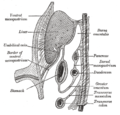Transverse colon
| Transverse colon | |
|---|---|
colon seen from front (transverse colon coloured blue) | |
 | |
| Details | |
| Precursor | Midgut (first 2/3) Hindgut (last 1/3) |
| Artery | Middle colic artery |
| Vein | Middle colic vein |
| Identifiers | |
| Latin | colon transversum |
| MeSH | D044684 |
| TA98 | A05.7.03.004 |
| TA2 | 2984 |
| FMA | 14546 |
| Anatomical terminology] | |
In
human anatomy, the transverse colon is the longest and most movable part of the colon
.
Anatomical position
It crosses the
left colic flexure
(splenic flexure).
In its course, it describes an arch, the concavity of which is directed backward and a little upward. Toward its splenic end there is often an abrupt U-shaped curve which may descend lower than the main curve.
It is almost completely invested by the
transverse mesocolon
.
It is in relation, by its upper surface, with the
.Function
The transverse colon absorbs water and salts.
Additional images
-
Inner diameters of different sections of the large intestine, with transverse colon (at top) measuring on average 5.8 cm (range 5.0-6.5 cm).[1]
-
Intestines
-
Schematic figure of the bursa omentalis, etc. The human embryo of eight weeks
-
Front view of the thoracic and abdominal viscera
-
Digestive system
-
Transverse colon
See also
- Colon
References
- PMID 20689513.
![]() This article incorporates text in the public domain from page 1180 of the 20th edition of Gray's Anatomy (1918)
This article incorporates text in the public domain from page 1180 of the 20th edition of Gray's Anatomy (1918)
External links
- Anatomy figure: 37:06-03 at Human Anatomy Online, SUNY Downstate Medical Center - "The large intestine."


![Inner diameters of different sections of the large intestine, with transverse colon (at top) measuring on average 5.8 cm (range 5.0-6.5 cm).[1]](http://upload.wikimedia.org/wikipedia/commons/thumb/2/22/Diameters_of_the_large_intestine.svg/120px-Diameters_of_the_large_intestine.svg.png)




